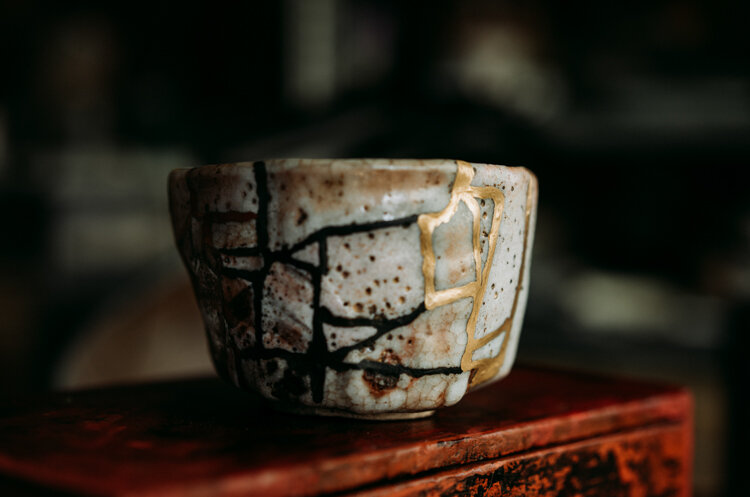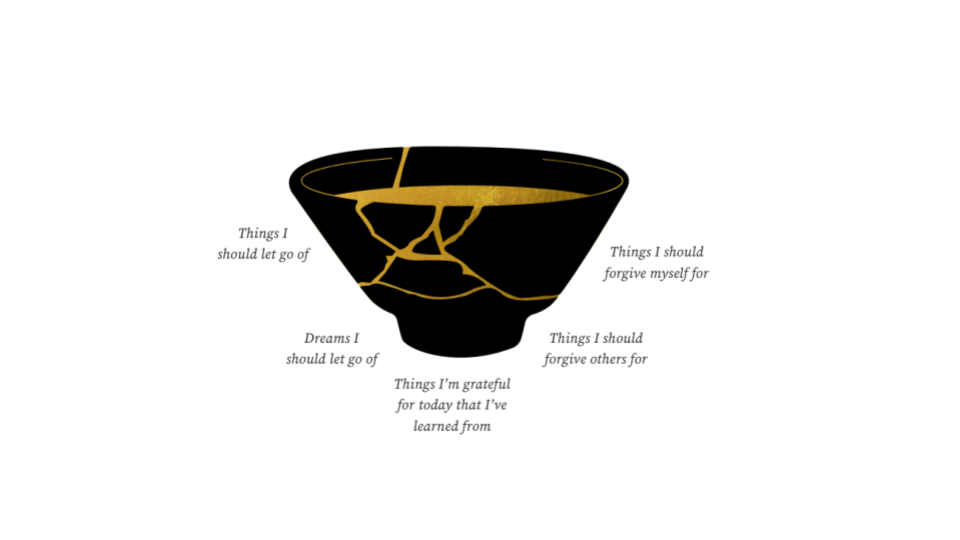Kintsugi – Scars of Gold
The Meaning of Kintsugi
Kintsugi 金継ぎ is the Japanese art of putting broken things back together again. It literally means ‘golden reassembly’.
© Photograph: Motoki Tonn
The origin of kintsugi is unknown. According to legend, the technique originated at the end of the 15th century when the Chinese tea bowl of Shogun Ashikaga Yoshimasa broke. According to legend, he sent the bowl to China for repair. When the bowl returned, it was mended with staples, a process in which metal is inserted into drilled holes on either side of the break to hold the pieces together. Yoshimasa didn't like the look and asked Japanese craftsmen to develop a new, more aesthetic method - the beginnings of kintsugi.
It is unclear how much of this story is true; it suggests that kintsugi was not widely practised until after the 15th century, around the time the Japanese tea ceremony was developed. This custom, an intimate gathering with specific and strict rules, emphasises the relationship between host, guests and the objects surrounding them, such as hanging pictures and tea utensils.
At the end of the 19th century, the Japanese tea master Sen Rikyū and others refined the tea ceremony and established the aesthetics of wabi and sabi, which were also important for the development of Japanese ceramics
A Short Film about Kintsugi – Filmed in Japan
„The art of Kintsugi asks us to become still, to practise patience - to wait and observe. It shows us that scars only heal slowly. At the same time, we can gain new perspectives in the process. Kintsugi can also teach us to understand beauty in a new way.“
Kintsugi Philosophy
In the Kintsugi philosophy lies a rejection of perfectionism and supposed external beauty, and at the same time an acceptance and demonstration of courage to face brokenness. Kintsugi also means engaging in a longer process - because repair takes weeks and months and involves longer periods of rest, which is often overlooked; more on this later.
The Kintsugi philosophy requires an attitude of patience, attention and care for the process - then something unique and new can emerge from broken. We see the emergence of a new creation, a new work of art in a new form.
Kintsugi enables new perspectives
Kintsugi can be a life-changing metaphor for our lives. When we apply the teachings of Kintsugi philosophy to our lives, this craft can unleash the power to make a situation appear in a new light. Life experiences that we remember as "broken" or "lost" can be given a new twist.
Our lives are not always linear, and not everything always goes our way. How we view our fragments and how we make connections from individual life events is our choice. Kintsugi philosophy opens up the opportunity for us to discover a coherent story in our fragments. Kintsugi enables us to understand fragmentation experiences in a larger, coherent narrative.
Kintsugi enables new contexts of meaning
How can individual puzzle pieces of our lives that seem incoherent make a picture?
Kintsugi has the power to give our story a context of meaning. The vessel is transformed into a new shape. The new shape is in turn unique in itself, and at the same time the old shape remains in basic features. We can recognize both the old and the new - with scars of gold.
Appreciate fractures
We can recognize: Each break, each individual part is unique. Instead of repairing an object as if it were new, the centuries-old technique highlights the "scars" as parts of the new shape, it makes them shine. The scars are not concealed but emphasized. They are not suppressed but given appreciation.
Even when things break, we can discover new treasures that were hidden inside.
Kintsugi as a metaphor for our lives
Even when things break, we can discover new treasures that are hidden inside.
When we turn to our fragments, we can not only gain new perspectives, but we can also discover new things that have remained hidden from us until now. In a figurative sense, "light falls on our shadows". As a result, new riches can emerge from supposed mistakes, as a participant impressively reported at one of our seminars.
„Kintsugi art asks us to become still, to practice patience - to wait and observe. It shows us that scars heal only slowly. At the same time, we can gain new perspectives in the process. Kintsugi can also teach us to understand beauty in a new way.“
Kintsugi as a Philosophy of Life
We can apply the process of the Kintsugi art to our own lives. This enables a new perspective on dealing with changes, challenges and physical and emotional injuries. The metaphor of Kintsugi can be translated into attitudes to life. We have developed the acronym:
K.I.N.T.S.U.G.I.
K: Kindness - ‘karu’, a Germanic word - it stands for an attitude of friendliness and care.
I: Investigation - approaching the process with care, attention and patience.
N: Noting - noticing, analysing what needs attention, which strategy helps - and also what needs a break.
T: Touch - Touch is something precious, intimate - and can also facilitate a new connection to the injury and thus a healing process. What can I (not) touch?
S: Silence - The Kintsugi process is characterised by pauses and silence. The vessel needs to rest before moving on to the next step. The connections must become stable. In the supposed stillness, the shape becomes strong.
U: Utensils - what resources and tools are available to us? What experiences from the past can we activate?
G: Gold - gold represents dignity and transformation. The scars are not hidden, on the contrary, they show the changed form in new splendour.
I: Intention - what is possible now? Kintsugi is far more than an external process. The real change takes place on the inside. What have we learnt, what is now possible? What do these experiences enable us to do?
The Final Piece
Take a look at the final Kintsugi piece—an artwork created through a careful and deliberate repair process. What was once broken has been restored, with its golden seams highlighting the value of resilience and transformation.









